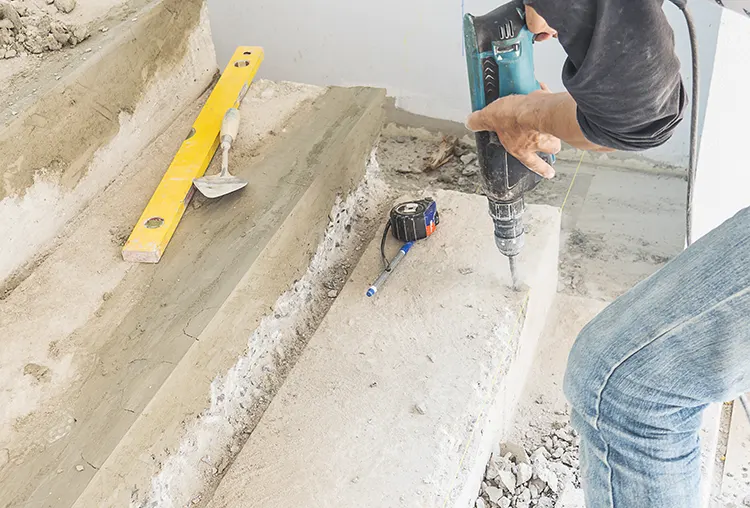Hello, New Yorkers! Have you ever noticed the crooked, uneven concrete surfaces in your neighborhood? The ones that make you feel like you’re on a miniature roller coaster? So, guess what? This problem has a terrific remedy known as “concrete leveling.” So, let’s get started and learn how to keep our walkways and driveways nice and level no matter what the Long Island weather throws at us!
Concrete leveling, called slab leveling or concrete lifting, works like magic on sunken and uneven concrete surfaces. It’s like giving your concrete a jolt, allowing it to restore its smooth, even appearance.
What Causes Uneven Concrete?
Let us now discuss New York’s weather adventures. We have a wide range of weather, from hot summers to cold winters. However, this weather might cause the ground beneath your concrete to shift and move. This can cause voids or empty spaces under the concrete over time, so you may see certain areas sinking while others remain stationary. It’s almost like a miniature earth ballet beneath our feet!
When Is Concrete Leveling Necessary?
That is an excellent question! If you notice uneven concrete, it’s time to think about concrete leveling. Be on the lookout for:
-
Bumpy Sidewalks:
If your once-smooth sidewalk has become more bumpy than a gravel road, concrete leveling can bring it back to life.
-
Driveway Dips:
Does your automobile bounce as you enter and exit your driveway? Concrete leveling is the solution.
-
Patio Puzzles:
Are uneven patio slabs ruining your outdoor gatherings? Concrete leveling can restore balance.
-
Poolside Problems:
If your pool deck has become a jumble of hills, concrete leveling will assist you in reclaiming your flat, poolside paradise.
Professional Concrete Leveling Process
The process of concrete leveling involves raising sunken or uneven concrete slabs to their original position. This is typically done using one of three main methods: mudjacking, polyurethane foam injection, or self-leveling compounds. Here’s a step-by-step breakdown of each method:
1. Mudjacking (Slabjacking)
Mudjacking is a traditional method used to lift and stabilize sinking concrete slabs, such as sidewalks, driveways, and patios.
Process:
- Drilling Holes – Small holes (about 1-2 inches in diameter) are drilled into the affected concrete slab.
- Injecting Slurry – A mixture of cement, sand, and other materials (slurry) is pumped through the holes to fill the voids beneath the slab.
- Lifting the Slab – As the slurry fills the empty space, it raises the concrete slab back to its original position.
- Sealing Holes – Once the leveling is complete, the holes are patched, and the surface is cleaned.
✅ Pros: Cost-effective, quick, and provides long-lasting results.
❌ Cons: The material used can be heavy and may cause further settling over time.
2. Polyurethane Foam Injection
This is a modern alternative to mudjacking, often preferred for its precision and durability.
Process:
- Drilling Small Holes – Tiny holes (about ⅝ inches) are drilled into the concrete.
- Injecting Polyurethane Foam – A two-part polyurethane foam is injected into the holes. The foam expands, filling voids and lifting the slab.
- Curing and Hardening – The foam hardens within minutes, providing a stable, water-resistant base.
- Sealing and Finishing – The drilled holes are patched, and the surface is ready for use within hours.
✅ Pros: Lightweight, quick curing (ready in 15 minutes), and more resistant to moisture.
❌ Cons: More expensive than mudjacking.
3. Self-Leveling Concrete
Used for indoor applications like basement floors, self-leveling concrete is a liquid mixture that spreads evenly over an uneven surface.
Process:
- Surface Preparation – The area is cleaned, and a primer is applied.
- Mixing and Pouring – A self-leveling compound is mixed with water and poured onto the floor.
- Spreading and Leveling – The liquid spreads evenly, filling in low spots and creating a smooth surface.
- Curing – It hardens within a few hours and is ready for flooring installation.
✅ Pros: Great for interior surfaces, easy to apply, and provides a smooth finish.
❌ Cons: Not suitable for outdoor slabs or large voids.
Which Method is Best?
- Mudjacking – Ideal for driveways, sidewalks, and patios with minor settling.
- Polyurethane Foam Injection – Best for heavier slabs and long-lasting results.
- Self-Leveling Concrete – Perfect for interior flooring projects
Concrete Leveling Costs in Long Island, Brooklyn, Queens, the Bronx
Concrete leveling costs in Long Island, Brooklyn, Queens, and the Bronx can vary based on the specific method used, the size of the area, and the extent of the damage. Below is a general overview of the average costs associated with different concrete leveling methods:
|
Concrete Leveling Method |
Average Cost Range |
|
Mudjacking |
$585 – $5,400 |
|
Polyurethane Foam Injection |
$875 – $8,100 |
|
Stone Slurry Grout Leveling |
$750 – $6,000 |
Note: These estimates are based on national averages and can vary depending on the specific project requirements and local market conditions.
For a more precise estimate tailored to your specific location and project, it’s advisable to consult with local concrete leveling contractors. For instance, in Brooklyn, NY, the average cost of mudjacking services ranges from $1,800 to $2,291, with some projects costing as low as $820 or as high as $4,500.
Given the variability in costs due to factors such as the size of the area, extent of the damage, and the chosen leveling method, obtaining quotes from multiple local contractors is recommended to ensure you receive the best value for your project.
When Concrete Leveling is Appropriate:
- Minor Settling or Unevenness: If concrete surfaces like driveways, sidewalks, or patios have minor settling or unevenness, leveling can effectively restore them.
- Stable Subsoil Conditions: Concrete leveling is most effective when the underlying soil is stable. If the soil has settled but remains compact, leveling can provide a long-term solution.
- Cost-Effective Repairs: Leveling is often more economical than full replacement, especially when the concrete is in good condition but has minor unevenness.
When to Avoid Concrete Leveling:
- Severely Damaged or Crumbling Concrete: If the concrete is extensively cracked, crumbling, or has numerous small fragments, leveling may not be effective. In such cases, replacement is often necessary to ensure stability and appearance.
- Unstable or Poor Subsoil Conditions: If the ground beneath the concrete is unstable or has ongoing settlement issues, leveling may provide only a temporary fix. Addressing the underlying soil problems is crucial before considering leveling.
- Structural Integrity Concerns: When the concrete’s structural integrity is compromised, such as in foundations or load-bearing surfaces, leveling might not suffice. Comprehensive structural repairs or replacements could be necessary.
- Design or Aesthetic Changes: If you’re planning significant design changes or aesthetic upgrades, replacing the concrete might be more appropriate than leveling.
- Environmental Conditions: Extreme weather conditions, such as very hot, humid, cold, or wet weather, can affect the effectiveness of leveling compounds. It’s advisable to perform leveling during moderate weather to ensure optimal results.
In summary, concrete leveling is a practical solution for minor unevenness when the concrete is in good condition and the underlying soil is stable. However, in cases of severe damage, unstable subsoil, or compromised structural integrity, alternative solutions like concrete replacement should be considered. Consulting with a professional concrete contractor can provide a thorough assessment and guide you to the best course of action for your specific situation.
Call us for a free inspection today at (347) 284-0280

